The History Book Club discussion
ART - ARCHITECTURE - CULTURE
>
RENAISSANCE
date newest »
newest »
 newest »
newest »
 Life in Italy During the Renaissance:
Life in Italy During the Renaissance: The Magnificent Times of Art and Culture

Siena - Santa Maria della Scala - Care of the Sick by Domenico di Bartolo
The Renaissance or rebirth began in Italy at the end of the fourteenth century and became an era of many cultural and architectural achievements in Europe. The Renaissance first began in Tuscany and was centered on the republics of Siena and Florence after the decimation left in the wake of the Black Death. The end of the Renaissance period marked the transition of the continent from medieval to the early modern era in Europe. The term Renaissance itself is quite modern, since it began to be used by historians only in the 19th century.
Later, it also had a great impact on the Republic of Venice and would also spread towards Rome. It was in the Eternal City where various structures from Ancient Rome were rebuilt by the popes in the 16th century.
The peak of the Renaissance occurred towards the end of the 15th century, a time when numerous foreign invasions began in Italy. This was the beginning of the famous Italian Wars, which saw Renaissance advancements in science be applied to warfare. It was also during this time, the beginning of the 15th century, that elements of the Italian Renaissance spread to the other countries in Europe which led to a European-wide rediscovery of art and science.
The remainder of the article: Life in Italy during Renaissance
Source: Life in Italy
 How to Do It: Guides to Good Living for Renaissance Italians
How to Do It: Guides to Good Living for Renaissance Italians by Rudolph M. Bell (no photo)
by Rudolph M. Bell (no photo)Overview:
How to Do It shows us sixteenth-century Italy from an entirely new perspective: through manuals which were staples in the households of middlebrow Italians merely trying to lead better lives. Addressing challenges such as how to conceive a boy, the manuals offered suggestions such as tying a tourniquet around your husband's left testicle. Or should you want to goad female desires, throw 90 grubs in a liter of olive oil, let steep in the sun for a week and apply liberally on the male anatomy. Bell's journey through booklets long dismissed by scholars as being of little literary value gives us a refreshing and surprisingly fun social history.
"Lively and curious reading, particularly in its cascade of anecdote, offered in a breezy, cozy, journalistic style." —Lauro Martines, Times Literary Supplement
"[Bell's] fascinating book is a window on a lost world far nearer to our own than we might imagine. . . . How pleasant to read his delightful, informative and often hilarious book." —Kate Saunders, The Independent
 Thank you Vicki for the comment...looking for beatiful pictures to make posts more interesting is actually my favorite part of researching for the threads.
Thank you Vicki for the comment...looking for beatiful pictures to make posts more interesting is actually my favorite part of researching for the threads.
 The Controversy of Renaissance Art
The Controversy of Renaissance Art by Alexander Nagel (no photo)
by Alexander Nagel (no photo)Overview:
Many studies have shown that images—their presence in the daily lives of the faithful, the means used to control them, and their adaptation to secular uses—were at the heart of the Reformation crisis in northern Europe. But the question as it affects the art of Italy has been raised only in highly specialized studies.
In this book, Alexander Nagel provides the first truly synthetic study of the controversies over religious images that pervaded Italian life both before and parallel to the Reformation north of the Alps. Tracing the intertwined relationship of artistic innovation and archaism, as well as the new pressures placed on the artistic media in the midst of key developments in religious iconography, The Controversy of Renaissance Art offers an important and original history of humanist thought and artistic experimentation from one of our most acclaimed historians of art.
 The Art of Mantua: Power and Patronage in the Renaissance
The Art of Mantua: Power and Patronage in the Renaissance by Barbara Furlotti (no photo)
by Barbara Furlotti (no photo)Synopsis:
This book traces the rich history of the northern Italian city of Mantua, from its mythic origins in Dante's Inferno, to its cultural heyday during the Renaissance under the patronage of the powerful Gonzaga family, to its eventual decline and annexation by the Austro-Hungarian Empire.
The fortunes of Mantua rose and fell with those of the Gonzaga family, who ruled as imperial vicars from the fourteenth to the early seventeenth century. They transformed the city into a major cultural center by commissioning works from the master architects and artists of the day such as Leon Battista Alberti, Giulio Romano, Titian, Rubens, and Guercino. However, Andrea Mantegna--who served as the court painter from 1460 to 1506 and whose technical mastery revolutionized painting--is the artist most identified with the city.
Although most of Mantua's artistic treasures were sold or claimed as war spoils upon the decline of the Gonzaga family, the rich cultural legacy of this fascinating city lives on in the collections of many of the world's premier museums.
 The Italian Renaissance
The Italian Renaissance by J.H. Plumb (no photo)
by J.H. Plumb (no photo)Synopsis:
Spanning an age that witnessed great achievements in the arts and sciences, this definitive overview of the Italian Renaissance will both captivate ordinary readers and challenge specialists. Dr. Plumb’s impressive and provocative narrative is accompanied by contributions from leading historians, including Morris Bishop, J. Bronowski, Maria Bellonci, and many more, who have further illuminated the lives of some of the era’s most unforgettable personalities, from Petrarch to Pope Pius II, Michelangelo to Isabella d'Este, Machiavelli to Leonardo. A highly readable and engaging volume, THE ITALIAN RENAISSANCE is a perfect introduction to the movement that shaped the Western world.
You have breathed such life to these threads - hope folks join in to discuss these beauties and ages.
 House of Borja or Borgia
House of Borja or Borgia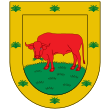
The Borja/Borgia coat of arms
Overview:
The Borgia (/ˈbɔrdʒəˌ -ʒə/; Italian: [ˈbɔrdʒa]; Spanish: Borja [ˈborxa]; Valencian: Borja [ˈbɔɾdʒa]) family became prominent during the Renaissance in Italy. They were from Valencia, the surname being a toponymic from Borja, then in the kingdom of Aragon, in Spain.
The Borgias became prominent in ecclesiastical and political affairs in the 15th and 16th centuries, producing two popes: Alfons de Borja, who ruled as Pope Callixtus III during 1455–1458, and Rodrigo Lanzol Borgia, as Pope Alexander VI, during 1492–1503.
Especially during the reign of Alexander VI, they were suspected of many crimes, including adultery, incest, simony, theft, bribery[citation needed], and murder (especially murder by arsenic poisoning).[1] Because of their grasping for power, they made enemies of the Medici, the Sforza, and the Dominican friar Savonarola, among others. They were also patrons of the arts who contributed to the Renaissance.
Early history
The Borja or Borgia emerged from Valencia in Spain. There were numerous unsubstantiated claims that the family was of Jewish origin. These underground rumours were propagated by, among others, Giuliano della Rovere, and the family was frequently described as marranos by political opponents. The rumours have persisted in popular culture for centuries, listed in the Semi-Gotha of 1912.
Cesare Borgia
Cesare was Rodrigo Borgia's second son with Vannozza dei Cattanei. Cesare's education was precisely planned by his father: he was educated by tutors in Rome until his 12th birthday. He grew up to become a charming man skilled at war and politics. He studied law and the humanities at the University of Perugia, then went to the University of Pisa to study theology. As soon as he graduated from the university, his father made him a cardinal.
Cesare was suspected of murdering his brother Giovanni, but there is no clear evidence to confirm this. However, Giovanni’s death cleared the path for Cesare to become a layman and gain the honors his brother received from their father, Pope Alexander VI. Although Cesare had been a cardinal, he left the holy orders to gain power and take over the position Giovanni once held: a condottiero. He was finally married to French princess Charlotte d'Albret.
After Alexander’s death in 1503, Cesare affected the choice of a next Pope. He needed a candidate who would not threaten his plans to create his own principality in Central Italy. Cesare’s candidate (Pius III) did become Pope, but he died a month after the selection. Cesare was now forced to support Giuliano della Rovere. The cardinal promised Cesare that he could keep all of his titles and honors. Later, della Rovere betrayed him and became his fiercest enemy.
Cesare died in 1507, at Viana Castle in Navarre, Spain while besieging the rebellious army of Count de Lerín. The castle was held by Louis de Beaumont at the time it was besieged by Cesare Borgia and King John's army of 10,000 men in 1507. In order to attempt to breach the extremely strong, natural fortification of the castle, Cesare counted on a desperate surprise attack. Not only did he fail to take the castle, he was killed during the battle.

Cesare and Lucrezia Borgia
Lucrezia Borgia
Lucrezia was born in Subiaco, Italy to Cardinal Rodrigo Borgia and Roman mistress Vanozza Catanei. Before the age of 13, she was engaged to two Spanish princes. After her father became Pope she was married to Giovanni Sforza in 1493 at the age of 13. It was a typical political marriage to improve Alexander's power; however, when Pope Alexander VI did not need the Sforzas any more, the marriage was annulled in 1497, on the dubious grounds that it had never been consummated.
Shortly afterwards she was involved in a scandal involving her alleged relationship with a Pedro Calderon, a Spaniard generally known as Perotto. His body was found in the Tiber on February 14, 1498 along with the body of one of Lucrezia's ladies. It is likely that Cesare had them killed as an affair would have damaged the negotiations being conducted for another marriage. During this time rumors were also spread suggesting that a child born at this time, Giovanni Borgia, also known as the Infans Romanus (child of Rome) was Lucrezia's.
Lucrezia’s second marriage, to wealthy young Prince Alfonso of Aragon, allowed the Borgias to form an alliance with another powerful family. However, this relationship did not last long either. Cesare wished to strengthen his relations with France and completely break with the Kingdom of Naples. As Alfonso's father was the ruler of the Kingdom of Naples, the young husband was in great danger. Although the first attempt at murder did not succeed, Alfonso was eventually strangled in his own quarters.
Lucrezia's third and final husband was Alfonso I d'Este, Duke of Ferrara. After her father died in 1503, she lived a life of freedom in Ferrara with her husband and children. Unfortunately, her pregnancies were difficult and she lost several babies after birth. She died in 1519, 10 days after the birth and death of her last child, Isabella Maria. She was buried in a tomb with Isabella and Alfonso.
Lucrezia was a budding capitalist entrepreneur, leveraging her own capital by obtaining marshland at negligible cost and then investing in massive reclamation enterprises. She also raised livestock and rented parts of her newly arable land for short terms, nearly doubling her annual income in the process.

The House of Borja/Borgia family tree
Source: Wikipedia
More on the Borgias:
 by
by
 G.J. Meyer
G.J. Meyer
 House of Medici
House of Medici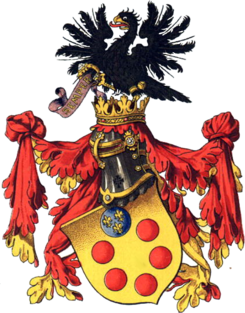
Coat of arms of the House of Medici
Overview:
The House of Medici (/ˈmɛdɨtʃi/ MED-i-chee; Italian pronunciation: [de ˈmɛːditʃi]) was an Italian banking family, political dynasty and later royal house that first began to gather prominence under Cosimo de' Medici in the Republic of Florence during the late 14th century. The family originated in the Mugello region of the Tuscan countryside, gradually rising until they were able to fund the Medici Bank. The bank was the largest in Europe during the 15th century, seeing the Medici gain political power in Florence — though officially they remained citizens rather than monarchs.
The Medici produced four Popes of the Catholic Church—Pope Leo X (1513–1521), Pope Clement VII (1523–1534), Pope Pius IV (1559–1565), and Pope Leo XI (1605);[1] two regent queens of France—Catherine de' Medici (1547–1559) and Marie de' Medici (1600–1610); and, in 1531, the family became hereditary Dukes of Florence. In 1569, the duchy was elevated to a grand duchy after territorial expansion. They ruled the Grand Duchy of Tuscany from its inception until 1737, with the death of Gian Gastone de' Medici. The grand duchy witnessed degrees of economic growth under the earlier grand dukes, but by the time of Cosimo III de' Medici, Tuscany was fiscally bankrupt.
Their wealth and influence initially derived from the textile trade guided by the guild of the Arte della Lana. Like other signore families, they dominated their city's government, they were able to bring Florence under their family's power, and they created an environment where art and humanism could flourish. They along with other families of Italy, such as the Visconti and Sforza of Milan, the Este of Ferrara, and the Gonzaga of Mantua, fostered and inspired the birth of the Italian Renaissance.
The Medici Bank was one of the most prosperous and most respected institutions in Europe. There are some estimates that the Medici family were the wealthiest family in Europe for a time. From this base, they acquired political power initially in Florence and later in wider Italy and Europe. A notable contribution to the profession of accounting was the improvement of the general ledger system through the development of the double-entry bookkeeping system for tracking credits and debits. The Medici family were among the earliest businesses to use the system.
Origins
The Medici family came from the agricultural Mugello region,north of Florence, being mentioned for the first time in a document of 1230. The origin of the name is uncertain. Medici is the plural of medico, also written "del medico" or "delmedigo", meaning, "medical doctor". It has been suggested that the name derived from one Medico di Potrone, a castellan of Potrone in the late 11th century, who presumably was the family's ancestor.
The dynasty began with the founding of the Medici Bank.
Cosimo de' Medici
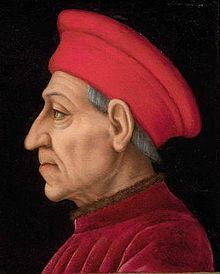
A portrait of Cosimo de' Medici
Cosimo di Giovanni de' Medici (27 September 1389 – 1 August 1464) was the first of the Medici political dynasty also known as "Cosimo 'the Elder'" ("il Vecchio") and "Cosimo Pater Patriae" (Latin: 'father of the nation'). His power derived from his great wealth as a banker, and he was a great patron of learning, the arts and architecture. He used his vast fortune of an estimated 150 000 gold florins (almost 30 million USD or 22 million Euro today) to control the Florentine political system and sponsor a series of artistic accomplishments.
His power over Florence stemmed from his wealth, which he used to control votes. As Florence was proud of its 'democracy', he pretended to have little political ambition, and did not often hold public office.In 1433 Cosimo's power over Florence, which he exerted without occupying public office, began to look like a menace to the anti-Medici party, led by figures such as Palla Strozzi and Rinaldo degli Albizzi: in September of that year he was imprisoned, accused for the failure of the conquest of Lucca, but he managed to turn the jail term into one of exile. He went to Padua and then to Venice, taking his bank along with him. Prompted by his influence and his money, others followed him: within a year, the flight of capital from Florence was so great that the ban of exile had to be lifted. Cosimo returned a year later in 1434, to greatly influence the government of Florence (especially through the Pitti and Soderini families) and to lead by example for the rest of his long life.
Catherine de' Medici
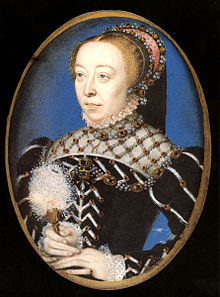
A portrait of Caterina de' Medici
Catherine de' Medici (Italian: Caterina de' Medici pronounced [kateˈriːna de ˈmɛːditʃi]; French Catherine de Médicis pronounced: [katʁin də medisis], 13 April 1519 – 5 January 1589), daughter of Lorenzo II de' Medici and of Madeleine de La Tour d'Auvergne, was an Italian noblewoman who was Queen of France from 1547 until 1559, as the wife of King Henry II. As the mother of three sons who became kings of France during her lifetime she had extensive, if at times varying, influence in the political life of France. For a time she ruled France as its regent.
Catherine believed in the humanist ideal of the learned Renaissance prince whose authority depended on letters as well as arms. She was inspired by the example of her father-in-law, King Francis I of France, who had hosted the leading artists of Europe at his court, and by her Medici ancestors. In an age of civil war and declining respect for the monarchy, she sought to bolster royal prestige through lavish cultural display. Once in control of the royal purse, she launched a programme of artistic patronage that lasted for three decades. During this time, she presided over a distinctive late French Renaissance culture in all branches of the arts.
Source: Wikipedia
More on the Medici family:
 by
by
 Paul Strathern
Paul Strathern
 German Renaissance
German Renaissance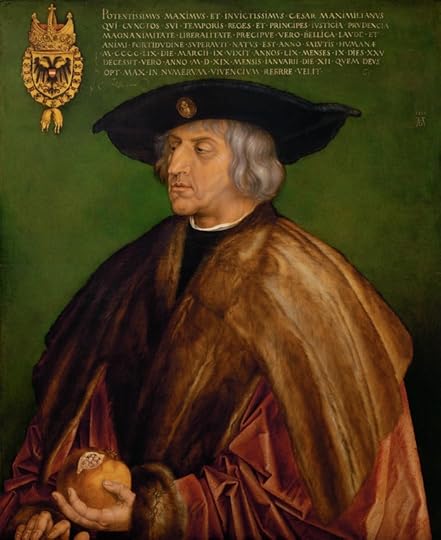
Portrait of Emperor Maximilian I (reigned: 1493-1519), the first Renaissance monarch of the Holy Roman Empire, by Albrecht Dürer, 1519.
Overview:
The German Renaissance, part of the Northern Renaissance, was a cultural and artistic movement that spread among German thinkers in the 15th and 16th centuries, which originated from the Italian Renaissance in Italy. This was a result of German artists who had traveled to Italy to learn more and become inspired by the Renaissance movement. The German Renaissance pushed classical thinking, arts, and the natural sciences to the forefront during this period of thinking within Germany.
The greatest mark of the Renaissance was the renewed interest in classical learning. Documents, papal or not, were being brought to the surface for examination and study. Classical learning and study was a must for any person living in the renaissance and was considered a great part of one's education. The basis of literature and art in this time were references back to times with Ancient Greek and Roman societies and mythology. The basis of natural science developed from that same look back into Greek and Roman philosophies and teaching, however they were more developed.
One thing to remember is this transition back to classical learning did not happen in a few years, the transition itself took over a century to occur within Germany. During this period many artists, scientists, and men of the church traveled to Italy. They brought back these ideals, and help thrust Germany into renaissance. The greatest influences of the German renaissance are marked for having brought the basis of Italian renaissance thinking, while still retaining their German culture.[citation needed] The Renaissance was also the result of economic development. At the beginning of the 16th century, Germany was one of the most prosperous countries in Europe in spite of a relatively low level of urbanization when compared to Italy or the Netherlands. It benefited from the wealth of certain sectors such as metallurgy, mining, banking and textile. More importantly, book-printing was more developed than in most other countries, something which facilitated the spread of knowledge.
Architecture
The Renaissance Architecture in Germany was inspired first by German philosophers and artists such as Albrecht Dürer and Johannes Reuchlin who visited Italy. Important early examples of this period are especially the Landshut Residence, the Castle in Heidelberg, Johannisburg Palace in Aschaffenburg, the City Hall and Fugger Houses in Augsburg and St. Michael in Munich. A particular form of Renaissance architecture in Germany is the Weser Renaissance, with prominent examples such as the City Hall of Bremen and the Juleum in Helmstedt.
In July 1567 the city council of Cologne approved a design in the Renaissance style by Wilhelm Vernukken for a two storied loggia for Cologne City Hall. St Michael in Munich is the largest Renaissance church north of the Alps. It was built by Duke William V of Bavaria between 1583 and 1597 as a spiritual center for the Counter Reformation and was inspired by the Church of il Gesù in Rome. The architect is unknown. Many examples of Brick Renaissance buildings can be found in Hanseatic old towns, such as Stralsund, Wismar, Lübeck, Lüneburg, Friedrichstadt and Stade. Notable German Renaissance architects include Friedrich Sustris, Benedikt Rejt, Abraham van den Blocke, Elias Holl and Hans Krumpper.

Juleum in Helmstedt (built 1592), an example of Weser Renaissance architecture
Influential people
Johannes Gutenberg (c. 1398–1468)
Born Johannes Gensfleisch zur Laden, Johannes Gutenberg is widely considered the most influential person within the German Renaissance. As a free thinker, humanist, and inventor, Gutenberg also grew up within the Renaissance, but influenced it greatly as well. His best-known invention is the printing press in 1440. Johannes Gutenberg's press allowed the humanists, reformists, and others to circulate their ideas. Essentially this is the basis of the Renaissance, the change and exchange of ideas. He is also known as the creator of the Gutenberg Bible, a crucial work that marked the start of the "Gutenberg Revolution" and the age of the printed book in the West.
Johann Reuchlin (1455–1522)
Johann Reuchlin was the most important aspect of world culture teaching within Germany at this time. He was a scholar of both Greek and Hebrew. Graduating, then going on to teach at Basel, he was considered extremely intelligent. Yet after leaving Basel, he had to start copying manuscripts and apprenticing within areas of law. However, he is most known for his work within Hebrew studies. Unlike some other "thinkers" of this time, Reuchlin submerged himself into this, even creating a guide to preaching within the Hebrew faith. The book, titled De Arte Predicandi (1503), is possibly one of his best-known works from this period.
Albrecht Dürer (1471–1528)
Albrecht Dürer was at the time, and remains, the most famous artist of the German Renaissance. He was famous across Europe, and greatly admired in Italy, where his work was mainly known through his prints. He successfully integrated an elaborate Northern style with Renaissance harmony and monumentality. Among his best known works are Melencolia I, the Four Horsemen from his woodcut Apocalypse series,[3] and Death, the Knight, and the Devil.[4] Other significant artists were Lucas Cranach the Elder, the Danube School and the Little Masters.
Martin Luther (1483–1546)
Martin Luther initiated the Protestant Reformation through the criticisms of church practices such as selling indulgences, which he published in his Ninety-Five Theses of 1517. Luther also translated the Bible into German, making the Christian scriptures more accessible to the general population and inspiring the standardization of the German language.
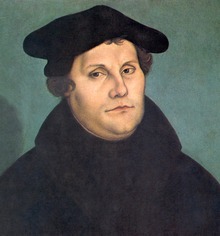
Martin Luther (1529) by Lucas Cranach the Elder
Source: Wikipedia
 Michelangelo: A Life in Six Masterpieces
Michelangelo: A Life in Six Masterpieces by
by
 Miles J. Unger
Miles J. UngerSynopsis:
The life of one of the most revolutionary artists in history, told through the story of six of his greatest masterpieces. Among the immortals--Leonardo, Rembrandt, Picasso--Michelangelo stands alone as a master of painting, sculpture, and architecture. He was not only the greatest artist in an age of giants, but a man who reinvented the practice of art itself. Throughout his long career he clashed with patrons by insisting that he had no master but his own demanding muse and promoting the novel idea that it was the artist, rather than the lord who paid for it, who was creative force behind the work. Miles Unger narrates the astonishing life of this driven and difficult man through six of his greatest masterpieces. Each work expanded the expressive range of the medium, from the "Pieta "Michelangelo carved as a brash young man, to the apocalyptic "Last Judgment," the work of an old man tested by personal trials. Throughout the course of his career he explored the full range of human possibility. In the gargantuan "David "he depicts Man in the glory of his youth, while in the tombs he carved for the Medici he offers a sustained meditation on death and the afterlife. In the Sistine Chapel ceiling he tells the epic story of Creation, from the perfection of God's initial procreative act to the corruption introduced by His imperfect children. In the final decades of his life, his hands too unsteady to wield the brush and chisel, he exercised his mind by raising the soaring vaults and dome of St. Peter's in a final tribute to his God. A work of deep artistic understanding, Miles Unger's "Michelangelo" brings to life the irascible, egotistical, and undeniably brilliant man whose artistry continues to amaze and inspire us after 500 years.
 English Renaissance
English RenaissanceThe English Renaissance was a cultural and artistic movement in England dating from the late 15th to the early 17th century. It is associated with the pan-European Renaissance that is usually regarded as beginning in Italy in the late 14th century. Like most of northern Europe, England saw little of these developments until more than a century later. The beginning of the English Renaissance is often taken, as a convenience, to be 1485, when the Battle of Bosworth ended the Wars of the Roses and inaugurated the Tudor Dynasty. Renaissance style and ideas, however, were slow to penetrate England, and the Elizabethan era in the second half of the 16th century is usually regarded as the height of the English Renaissance.
The English Renaissance is different from the Italian Renaissance in several ways. The dominant art forms of the English Renaissance were literature and music. Visual arts in the English Renaissance were much less significant than in the Italian Renaissance. The English period began far later than the Italian, which is usually considered to begin in the late 14th century, and was moving into Mannerism and the Baroque by the 1550s or earlier. In contrast, the English Renaissance can only be said to begin, shakily, in the 1520s, and continued until perhaps 1620.
Literature
England had a strong tradition of literature in the English vernacular, which gradually increased as English use of the printing press became common by the mid 16th century. By the time of Elizabethan literature a vigorous literary culture in both drama and poetry included poets such as Edmund Spenser, whose verse epic The Faerie Queene had a strong influence on English literature but was eventually overshadowed by the lyrics of William Shakespeare, Thomas Wyatt and others. Typically, the works of these playwrights and poets circulated in manuscript form for some time before they were published, and above all the plays of English Renaissance theatre were the outstanding legacy of the period. The works of this period are also affected by Henry VIII's declaration of independence from the Catholic Church and technological advances in sailing and cartography, which are reflected in the generally nonreligious themes and various shipwreck adventures of Shakespeare.
The English theatre scene, which performed both for the court and nobility in private performances, and a very wide public in the theatres, was the most crowded in Europe, with a host of other playwrights as well as the giant figures of Christopher Marlowe, Shakespeare and Ben Jonson.
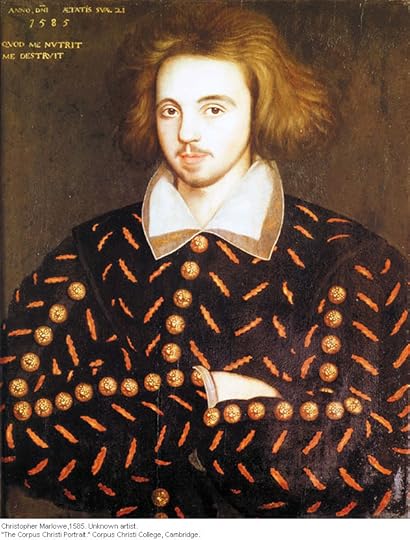
Christopher Marlowe
Visual arts
England was very slow to produce visual arts in Renaissance styles, and the artists of the Tudor court were mainly imported foreigners until after the end of the Renaissance; Hans Holbein was the outstanding figure. The English Reformation produced a huge programme of iconoclasm that destroyed almost all medieval religious art, and all but ended the skill of painting in England; English art was to be dominated by portraiture, and then later landscape art, for centuries to come. The significant English invention was the portrait miniature, which essentially took the techniques of the dying art of the illuminated manuscript and transferred them to small portraits worn in lockets. Though the form was developed in England by foreign artists, mostly Flemish like Lucas Horenbout, the somewhat undistinguished founder of the tradition, by the late 16th century natives such as Nicolas Hilliard and Isaac Oliver produced the finest work, even as the best producers of larger portraits in oil were still foreigners. The portrait miniature had spread all over Europe by the 18th century. The portraiture of Elizabeth I was carefully controlled, and developed into an elaborate and wholly un-realist iconic style, that has succeeded in creating enduring images.
Music
English Renaissance music kept in touch with continental developments far more than visual art, and managed to survive the Reformation relatively successfully, though William Byrd and other major figures were Catholic. The Elizabethan madrigal was distinct from, but related to the Italian tradition. Thomas Tallis, Thomas Morley, and John Dowland were other leading English composers.
The colossal polychoral productions of the Venetian School had been anticipated in the works of Thomas Tallis, and the Palestrina style from the Roman School had already been absorbed prior to the publication of Musica transalpina, in the music of masters such as William Byrd.
The Italian and English Renaissances were similar in sharing a specific musical aesthetic. In the late 16th century Italy was the musical center of Europe, and one of the principal forms which emerged from that singular explosion of musical creativity was the madrigal. In 1588, Nicholas Yonge published in England the Musica transalpina—a collection of Italian madrigals that had been Anglicized—an event which began a vogue of madrigal in England which was almost unmatched in the Renaissance in being an instantaneous adoption of an idea, from another country, adapted to local aesthetics. English poetry was exactly at the right stage of development for this transplantation to occur, since forms such as the sonnet were uniquely adapted to setting as madrigals: indeed, the sonnet was already well developed in Italy. Composers such as Thomas Morley, the only contemporary composer to set Shakespeare, and whose work survives, published collections of their own, roughly in the Italian manner but yet with a unique Englishness; interest in the compositions of the English Madrigal School have enjoyed a considerable revival in recent decades.
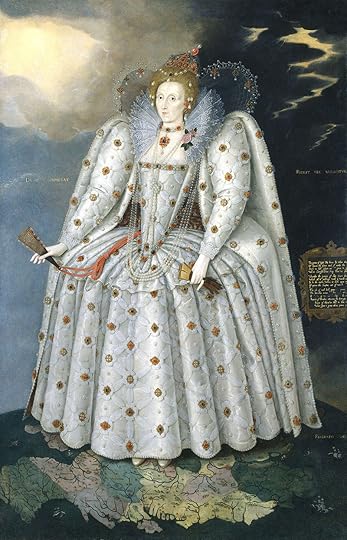
The Ditchley Portrait of Elizabeth I by the foreign Marcus Gheeraerts the Younger, c.1592
Architecture
Despite some buildings in a partly Renaissance style from the reign of Henry VIII, notably Hampton Court Palace, the vanished Nonsuch Palace, Sutton Place and Layer Marney Tower, it was not until the Elizabethan architecture of the end of the century that a true Renaissance style emerged, influenced far more by northern Europe than Italy. The most famous buildings are large show houses constructed for courtiers, and characterised by lavish use of glass, as at "Hardwick Hall, more glass than wall", Wollaton Hall and Hatfield House and Burghley House, the style continuing into the early 17th century before developing into Jacobean architecture. Lesser, but still large, houses like Little Moreton Hall continued to be constructed and expanded in essentially medieval half-timbered styles until the late 16th century. Church architecture essentially continued in a late Gothic style until the Reformation, and then stopped almost completely, although church monuments, screens and other fittings often had classical styles from about the mid-century. The few new church buildings were usually still Gothic in style, as in Langley Chapel of 1601.
Source: Wikipedia
 Spanish Renaissance
Spanish Renaissance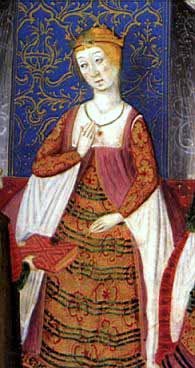
Image of Isabella I of Castile in the Rimado de la Conquista de Granada
The Spanish Renaissance refers to a movement in Spain, emerging from the Italian Renaissance in Italy during the 14th century, that spread to Spain during the 15th and 16th centuries.
This new focus in art, literature and science inspired by the Greco-Roman tradition of Classical antiquity, received a major impulse from several events in 1492:
- Unification of the longed-for Christian kingdom with the definitive taking of Granada, the last Islamic controlled territory in the Iberian Peninsula, and the successive expulsions of thousands of Muslim and Jewish believers,
- The official discovery of the western hemisphere, the Americas,
- The publication of the first grammar of a vernacular European language, the Gramática (Grammar) by Antonio de Nebrija.
The beginning of the Renaissance in Spain is closely linked to the historical-political life of the monarchy of the Catholic Monarchs. Its figures are the first to leave the medieval approaches that secured a feudal scheme of weak monarch over a powerful and restless nobility. The Catholic Monarchs unite the forces of the incipient state and ally with the principal families of the nobility to maintain their power. One of these families, the Mendoza, use the new style like distinction of its clan and, by extension, of the protection of the monarchy.
Little by little, the novel esthetic was introduced into the rest of the court and the clergy, mixing with purely Iberian styles, like the Nasrid art of the dying kingdom of Granada, the exalted and personal Gothic Castilian queen, and the Flemish tendencies in the official painting of the court and the Church. The assimilation of elements gave way to a personal interpretation of the orthodox Renaissance, which came to be called Plateresque. Therefore, secondary artists were brought in from Italy, apprentices were sent to the Italian shops, they brought designs, architectural plans, books and engravings, paintings, etc., of which portraits, themes and composition were copied.
King Charles I was more predisposed to the new art, paradoxically called the old way, remitted to the Classical antiquity. His direct patronage achieved some of the most beautiful works of the special and unique Spanish Renaissance style: the patronage of Almazan de Covarrubias, his commissions for Titian, who never agreed to relocate to Spain. Painters of great quality were, far from the courtier nucleus, Pedro Berruguete, Juan de Juanes, Paolo da San Leocadio, of whom the delicate Virgin of the Caballero de Montesa is highlighted, Yáñez de la Almazan and Gerardo de los Llanos.
The painting of the Spanish Renaissance is normally completed in oil. It realizes interiors perfectly subject to the laws of perspective, without over-emphasis of the people. The figures are all of the same size and anatomically correct.
The colors and the shading are applied in tonal ranges, according to the Italian teachings. To accentuate the Italian style, in addition, it is common to add elements directly copied from it, like the adornments a candelieri (borders of vegetables and cupids that surround the frames), or Roman ruins in the countrysides, including in scenes of the life of Christ.
Source: Wikipedia
 Renaissance Games
Renaissance GamesThe Florentines were excitable and emotional, and delighted in games of chance; they gave free play to their thought in movement or gesture, and engaged naturally in the production of drama; above all they were musical, and made playing on sweet-toned instruments and singing their favorite pastime during the Renaissance. Games of chance, leading to the vice of gambling, were developed to such a degree that no civil law could suppress them, and no moral teaching persuaded people to leave it. Even before the Renaissance period, in 1376, there was a law prohibiting the game of Naibi, which was played with painted cards, but the method of playing seems now to be lost. Among the by-laws of an ancient company, still preserved, is one which forbids the brethren to play with dice or naibi.
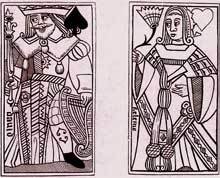
playing cards, 16th century
Even wealth and culture did not keep men from the evil habit, as is illustrated by the case of Buonaccorso Pitti, who occupied some of the highest posts of honor in Florence, and wrote a history of his own time. He traveled through a large part of Europe, gambling everywhere; and by his talents and affable manners made himself acceptable at numerous courts, including those of France and Burgundy. At one time he was master of the horse to the Duke of Orleans, who was assassinated November 23, 1407. On that day Pitti wrote in his diary, "I made a hundred gold florins to-day by a bargain in wool,"—thus showing that even in the midst of such a tragedy his spirit of speculation was active. He finally returned to Florence with a fortune, which was largely the product of his gaming. The money amassed in this manner was that which enabled his son Luca Pitti to acquire almost the first place in the state, and in his pride to commence building the famous Pitti palace, which was destined to become not a private, but a ducal, and finally a royal residence.
The gaming continued through all the epoch of the Renaissance. Games of cards like Frussi were much in favour, and it still continues to be played under the name of Primiera. In this game four cards are dealt to each player, and he who receives four of a kind wins the stakes. Lorenzo de' Medici refers to this game in one of his carnival songs, and speaks of it as maledetto or cursed; and advises him who wants to play to go into it very slowly, and stake but little and sparingly. He adds moreover, that in his day it was played by everybody, even by the peasants. Another game was the one called Bassetta, and was played by the dealer laying three cards on the table, and allowing each of the others to draw a card from the pack, with the chance, which was very small, of being able to match one of those already exposed. With these vices, the Florentines evidently combined the greater one of cheating; for in the Song of the Players reference is made to loaded dice and false cards.
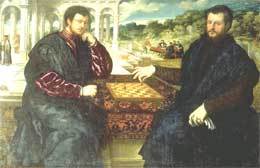
Paris Bondone-Chess Players, 1540
But there were also nobler Renaissance games as well, in which skill and strength were the elements of victory, not chance or cheating. One of the favorites among these was called Pallone. It was played with a ball of good size, filled with air, and struck by the fist from one to the other; the object being for each player not to let the ball come to rest on his side of the field. It is somewhere told of Pietro de' Medici, that he was so fond of this sport as even to neglect his business and the affairs of state in order to indulge his passion for it. Among the Renaissance games, Maglio was much beloved. It was a game of ball, which was played with a wooden ball and mallet. The ground devoted to this sport was on the east side of the church of San Marco, extending thence to the city wall. One player would challenge the others to knock the ball to a certain spot at a distance; and the winner was he who succeeded in placing the ball nearest the goal. The goal however was generally fixed at such a distance that only the one or two most expert players could drive the ball so far. This game was introduced into Florence about the year 1480, and was played with passion for the remainder of the century; but the Medici became dukes, and, lovers of less rough sport, prohibited its indulgence. Reference to it is also made in one of the carnival songs, where there is mention of the stiff backbone, good sight, and strong arms which are necessary to play it well.
Lovers of football will be pleased to know that it was one of the favorite Renaissance games which was also played at Florence during the days of republican rule, and was not prohibited at the incoming of the ducal regime. One of the preferred pastimes of the young men of the early part of the 16th Century was to have a band of music seated on the ridge of the roof of the noble church of Santa Croce and play, while twenty-five whites and twenty-five greens did battle for the football goal on the piazza. This game was called Calcio, a name preserved until this very day (every weekend I watch the Serie A calcio games!). And one day while they were carrying on their fun as above mentioned, someone, evidently horrified by the godlessness of the musical accompaniment from such a position, shot at the musicians, however, without hitting any of them.
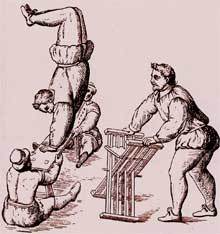
Somersaults, 16th Century
Another darling of the Renaissance games was chess. It was played in Florence at least as early as the beginning of the 14th Century; for there is record of that date of the murder of a certain Brunelleschi, while engaged in the game.
A game of strength and skill was Pome, and was for a time held in high esteem. It consisted in throwing a spear, while running, at a suspended apple.
From this partial enumeration we may conclude that the Renaissance games were offering people an agreeable pastime. They made people exercise, and they instilled energy, independence, and manhood.
Perhaps the most notable quality characteristic of the Renaissance games in general is their extreme simplicity. This idea is exhibited also in the street shows, which Florentines have enjoyed for ages. On May-day they were accustomed to decorate their front doors with green branches and to have their common merrymaking largely in the open air. One of the customs of their fête days was to erect platforms at the street corners, on which buffoons and prestidigitators showed their skill to the admiring crowds. It was on such a day, almost two centuries earlier, that the boy Dante met the young Beatrice Portinari, who was destined to exercise such an influence on the literature of all Italy.
Source: http://www.renaissance-spell.com/Rena...
 by Andrew Leibs (no photo)
by Andrew Leibs (no photo)
 Renaissance dance history
Renaissance dance history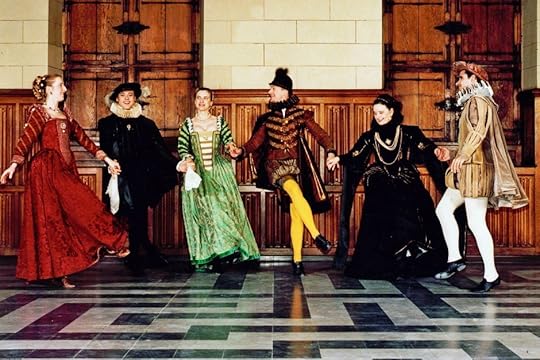
During the Renaissance period, there was a distinction between country dances and court dances. Court dances required the dancers to be trained and were often for display and entertainment, whereas country dances could be attempted by anyone. At Court, the formal entertainment would often be followed by many hours of country dances which all present could join in. Dances described as country dances such as Chiarantana or Chiaranzana remained popular over a long period - over two centuries in the case of this dance. A Renaissance dance can be likened to a ball.
Knowledge of court dances has survived better than that of country dances as they were collected by dancing masters in manuscripts and later in printed books. The earliest surviving manuscripts that provide detailed dance instructions are from 15th century Italy. The earliest printed dance manuals come from late 16th century France and Italy. The earliest dance descriptions in England come from the Gresley manuscript c.1500 found in the Derbyshire Record Office, D77 B0x 38 pp 51–79. These have been recently published as "Cherwell Thy Wyne (Show your joy): Dances of fifteenth-century England from the Gresley manuscript". The first printed English source appeared in 1652, the first edition of Playford.
The dances in these manuals are extremely varied in nature. They range from slow, stately dances (bassadance, pavane, almain) to fast, lively dances (galliard, coranto, canario). The former, in which the dancers' feet did not leave the ground were styled the dance basse while energetic dances with leaps and lifts were called the haute dance. Some were choreographed, others were improvised on the spot.
One dance for couples, a form of the galliard called lavolta, involved a rather intimate hold between the man and woman, with the woman being lifted into the air while the couple made a 3⁄4 turn. Other dances, such as branles or bransles, were danced by many people in a circle or line.
Our knowledge of 15th-century Italian dances comes mainly from the surviving works of three Italian dance masters: Domenico da Piacenza, Antonio Cornazzano and Guglielmo Ebreo da Pesaro. Their work deals with similar steps and dances, though some evolution can be seen. The main types of dances described are bassa danze and balletti. These are the earliest European dances to be well-documented, as we have a reasonable knowledge of the choreographies, steps and music used.
Source: Wikipedia
For further research:
Renaissance dance
 by Hal Leonard Publishing Company (no photo)
by Hal Leonard Publishing Company (no photo) by Isabel McNeill Carley (no photo)
by Isabel McNeill Carley (no photo)
 Renaissance warfare
Renaissance warfare
Giorgio Vasari: The Battle of Marciano (1565)
During the Renaissance, warfare became more frequent and much more destructive than in the Middle Ages. New technology, especially the introduction of gunpowder weapons and artillery, changed the nature of war. With the rise of more centralized states came the establishment of large standing armies. Some scholars have described the developments in the period between 1350 and 1600 as a military revolution.
Medieval warfare was limited in scope, often involving conflicts between individual nobles or between a noble and a prince. However, during the Renaissance some princes, particularly in France and Spain, grew much more powerful than their neighbors. In addition, some European rulers pursued a policy of building their kingdoms by conquering independent territories. War ceased to be a local affair. It often involved troops from many different lands who fought on soil far from home.
In the Renaissance wars were generally fought to defend one's territory, to acquire more territory for the state, or to gain control of the monarchy. Many European wars of the period involved disputes over inherited titles and territories. For example, the Wars of Italy (1494–1559) began because King Charles VIII of France claimed to be the rightful heir to the kingdom of Naples. However, the English monarchy's campaigns of conquest against Ireland and Scotland did not rest on any claims of inheritance but were driven by the desire to enlarge the kingdom. The Spanish and French kingdoms also grew by annexing territory, often by warfare.
Other factors had an impact on warfare. The chivalric ideal, which flourished during the Renaissance, led many men to fight for honor or glory. This attitude was common among the nobility, and even some mercenary captains, for whom war was a profession, would engage in combat for reasons of honor.
Arms and Armor in Renaissance Europe

wild boar hunt with spears
Although arms and armor are most commonly associated with warfare, both were used in other contexts, including hunting, tournaments, and as parade costume.
For warfare, arms and armor must, above all, be practical, affording the utmost protection and functionality without impairing body movement because of excess weight or inflexible material. Even such practical equipment, however, was often decorated, care being taken that the decoration would not impede its function.
Almost all types of weapons have been used in hunting, including bows, crossbows, and firearms, as well as special kinds of swords and spears. In rare instances, armor was worn for hunting bear or wild boar.
Early forms of the tournament were little different from military exercises, with combatants using the same equipment that they would have used in warfare. The first objects specifically for use in tournaments—such as extra plates for the protection of the throat and hands, or blunted lance heads—were introduced around 1300. During the late fourteenth century, equipment such as the shield and Great Helm were superceded on the battlefield by more sophisticated gear, but continued to be used in tournaments. This development ultimately led to the creation of specialized armor designed exclusively for certain types of tournament. Also important was the invention of the garniture, a basic suit of armor that, through the addition of further pieces and plates, could be adapted for various purposes both on the battlefield and in different types of tournament. The idea of highly specialized tournament armor lives on in some of today’s sports equipment.
The symbolic value of arms and armor was reflected in their use as display objects in tournaments, parades, and triumphal entries, and as funerary achievements (for instance, a grouping of weapons and armor hung over a knight’s tomb). During the Renaissance, some of the most sumptuous swords, maces, firearms, shields, and armor were made specifically for ceremonial purposes. Such armor was sometimes referred to as armor all’antica or alla romana. These objects were intended to imitate arms and armor of the style used by the heroes of classical antiquity and medieval chivalry. Worn or carried in processions or at court, they were designed to bestow upon the wearer the glory and fame, virtues and achievements of those antique military leaders, who Renaissance princes and commanders sought to emulate. Since these accoutrements were not intended to face the risk of damage or loss in battle, many of the functional and protective qualities of “normal” arms and armor—lightness, practicality, and the “glancing surface”— had been abandoned in favor of theatrical and symbolical effect.
Finally, mention must also be made of armor for horses and dogs. Whereas horses could be protected by or adorned with armor for most of the above occasions, armor for dogs was rare and only used—if at all—for hunting and warfare.
Sources: Encyclopedia.com and The Metropolitan Museum of Art
More:
 by Michael Edward Mallett (no photo)
by Michael Edward Mallett (no photo) by Thomas F. Arnold (no photo)
by Thomas F. Arnold (no photo) by J.R. Hale (no photo)
by J.R. Hale (no photo) by Bert S. Hall (no photo)
by Bert S. Hall (no photo) by
by
 Jeremy Black
Jeremy Black by
by
 Stephen Turnbull
Stephen Turnbull
 Cultural periods in Italian Renaissance - Trecento (14th Century)
Cultural periods in Italian Renaissance - Trecento (14th Century)
Giotto masterpiece in Padova's "Cappella degli Scroveni"
The Trecento (Italian pronunciation: [treˈtʃɛnto]; Italian for 300, short for "mille trecento," 1300) refers to the 14th century in Italian cultural history.
Commonly the Trecento is considered to be the beginning of the Renaissance in art history. Painters of the Trecento included Giotto di Bondone, as well as painters of the Sienese School, which became the most important in Italy during the century, including Duccio di Buoninsegna, Simone Martini, Lippo Memmi, Ambrogio Lorenzetti and his brother Pietro. Important sculptors included two pupils of Giovanni Pisano: Arnolfo di Cambio and Tino di Camaino, and Bonino da Campione.
The Trecento was also famous as a time of heightened literary activity, with writers working in the vernacular instead of Latin. Dante, Petrarch and Boccaccio were the leading writers of the age. Dante produced his famous La divina commedia (The Divine Comedy), a summation of the medieval worldview, and Petrarch wrote verse in a lyrical style influenced by the Provençal poetry of the troubadours.
In music, the Trecento was a time of vigorous activity in Italy, as it was in France, with which there was a frequent interchange of musicians and influences. Distinguishing the period from the preceding century was an emphasis on secular song, especially love lyrics; much of the surviving music is polyphonic, but the influence of the troubadours who came to Italy, fleeing the Albigensian Crusade in the early 13th century, is evident. In contrast to the artistic and literary achievements of the century, Trecento music (at least in written form) flourished in the second half of the century, and the period is often extended (especially in English-language scholarship) into the first decades of the 15th century, as a so-called "Long Trecento." Musicians and composers of the Trecento included the renowned Francesco Landini, as well as Maestro Piero, Gherardello da Firenze, Jacopo da Bologna, Giovanni da Cascia, Paolo "Tenorista" da Firenze, Niccolò da Perugia, Bartolino da Padova, Antonio Zachara da Teramo, Matteo da Perugia, and Johannes Ciconia.
Source: Wikipedia
 by James McKinnon (no photo)
by James McKinnon (no photo) by
by
 Dante Alighieri
Dante Alighieri by
by
 Giovanni Boccaccio
Giovanni Boccaccio by
by
 Francesco Petrarca
Francesco Petrarca
 Cultural periods in Italian Renaissance - Quattrocento (15th Century)
Cultural periods in Italian Renaissance - Quattrocento (15th Century)
Sandro Botticelli's Annunciation, painted 1489–1490
The cultural and artistic events of 15th century Italy are collectively referred to as the Quattrocento (Italian pronunciation: [ˌkwattroˈtʃɛnto]; from the Italian for the number 400, or from "millequattrocento," 1400). Quattrocento encompasses the artistic styles of the late Middle Ages (most notably International Gothic) and the early Renaissance.
After the decline of the Western Roman Empire in 476, economic disorder and disruption of trade spread across Europe. This was the beginning of the Early Middle Ages, which lasted roughly until the 11th century, when trade picked up, population began to expand and the papacy regained its authority.
In the late Middle Ages, the political structure of the European continent slowly evolved from small, highly unstable fiefdoms into larger nation states ruled by monarchies, thereby providing greater stability. In Italy, urban centers arose that were populated by merchant and trade classes, who were able to defend themselves. Money replaced land as the medium of exchange, and increasing numbers of serfs became freedmen. The changes in Medieval Italy and the decline of feudalism paved the way for social, cultural, and economic changes.
The Quattrocento is viewed as the transition from the Medieval period to the age of the Renaissance, principally in the cities of Rome, Florence, Milan, Venice and Naples.
Quattrocento art shed the decorative mosaics typically associated with Byzantine art along with the Christian and Gothic media of and styles in stained glass, frescoes, illuminated manuscripts and sculpture. Instead, Quattrocento artists and sculptors incorporated the more classic forms developed by Roman and Greek sculptors.
Source: Wikipedia
 by Stefano Ugo Baldassarri (no photo)
by Stefano Ugo Baldassarri (no photo) by Matteo Soranzo (no photo)
by Matteo Soranzo (no photo) by Oren Margolis (no photo)
by Oren Margolis (no photo) by Amos Edelheit (no photo)
by Amos Edelheit (no photo) by Timothy G. Verdon (no photo)
by Timothy G. Verdon (no photo) by Charles Dempsey (no photo)
by Charles Dempsey (no photo)
 Cultural periods in Italian Renaissance - Cinquecento (16th Century)
Cultural periods in Italian Renaissance - Cinquecento (16th Century)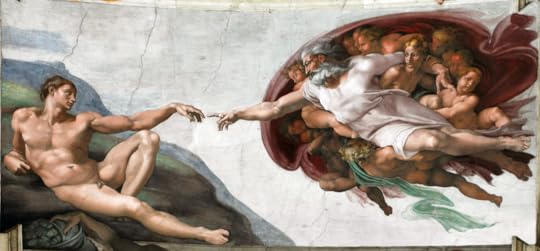
The Creation of Adam, a scene from Michelangelo's Sistine Chapel ceiling
Cinquecento (Italian pronunciation: [ˌtʃiŋkweˈtʃɛnto], 'five hundred'; short for millecinquecento '1500') was the Italian Renaissance of the 16th century, including the current styles of art, music, literature, and architecture.
Art
At the turn of the 16th century, especially in Northern Italy, artists began to use new techniques in the manipulation of light and darkness, such as the tone contrast evident in many of Titian's portraits and the development of sfumato and chiaroscuro by Leonardo da Vinci and Giorgione. The period also saw the first secular (non-religious) themes. Debate has ensued as to the secularism of the Renaissance emphasized by early 20th-century writers like Jacob Burkhardt due to the presence of these - actually few - mythological paintings. Botticelli was one of the main painters whose secular work comes down to us today, though he was deeply religious (a follower of Savonarola) and painted plenty of traditional religious paintings as well.
The period known as the High Renaissance represents the culmination of the goals of the earlier period, namely the accurate representation of figures in space rendered with credible motion and in an appropriately decorous style. The most famous painters from this time period are Leonardo da Vinci, Raphael, and Michelangelo Buonarroti. Their images are among the most widely known works of art in the world. Leonardo's The Last Supper, Raphael's The School of Athens and Michelangelo's Sistine Chapel ceiling are the textbook examples of this period.
High Renaissance painting evolved into Mannerism (c. 1520-80), especially in Florence. Mannerist artists, who consciously rebelled against the principles of High Renaissance, tend to represent elongated figures in illogical spaces. Contemporaries criticized this period as seeming artificial. Modern scholarship has recognized the capacity of Mannerist art to convey strong (often religious) emotion where the High Renaissance failed to do so. Some of the main artists of this period are Pontormo, Rosso Fiorentino, Parmigianino and Giulio Romano.

Musicians, ca 1600
Music
The music of Giovanni Pierluigi da Palestrina is probably the most archetypical Cinquecento music. He simplified some of the complexities of the music of the time, and advocated a more homophonic style. He was partially reacting to the strictures of the Council of Trent, which discouraged excessively complex polyphony as inhibiting understanding the text. He was the foremost member of the Roman School, a group of composers of predominantly church music, in Rome, spanning the late Renaissance into early Baroque eras. Many of the composers had a direct connection to the Vatican and the papal chapel, though they worked at several churches; stylistically they are often contrasted with the Venetian School of composers, a concurrent movement which was much more progressive.
In Venice, from about 1534 until around 1600, an impressive polychoral style developed, which gave Europe some of the grandest, most sonorous music composed up until that time, with multiple choirs of singers, brass and strings in different spatial locations in the Basilica San Marco di Venezia (see Venetian School). These multiple revolutions spread over Europe in the next several decades, beginning in Germany and then moving to Spain, France and England somewhat later, demarcating the beginning of what we now know as the Baroque musical era.
In the late 16th century, as the Renaissance era closes, an extremely manneristic style develops. In secular music, especially in the madrigal, there was a trend towards complexity and even extreme chromaticism (as exemplified in madrigals of Luzzaschi, Marenzio, and Gesualdo). The term "mannerism" derives from art history.
Literature
The most famous works of the Italian Renaissance, by Dante, Boccaccio, and Petrarch, were written in the 14th century, but continued to exert influence. Ludovico Ariosto (Orlando furioso), Baldassare Castiglione (The Book of the Courtier) and Niccolò Machiavelli (The Prince) were eminent writers of the Cinquecento.
Architecture
It was the result of the revival of classic architecture known as Renaissance, but the change had commenced already a century earlier, in the works of Ghiberti and Donatello in sculpture, and of Brunelleschi and Alberti in architecture. (Source: Wikipedia)
Boccaccio / Valois / Petronio (no photo)
Petrarca Francesco Slavitt David R (no photo)
 Dante Alighieri
Dante Alighieri by
by
 Ludovico Ariosto
Ludovico Ariosto by
by
 Baldassare Castiglione
Baldassare Castiglione by
by
 Niccolò Machiavelli
Niccolò MachiavelliFurther research:
(no image)Essays on Italian Music in the Cinquecento by Richard Charteris (no image)
 by Mark W. Roskill (no photo)
by Mark W. Roskill (no photo) by Felix Gilbert (no photo)
by Felix Gilbert (no photo) by Heidi Hornik (no photo)
by Heidi Hornik (no photo)
 The Civilization of the Renaissance in Italy
The Civilization of the Renaissance in Italy by
by
 Jacob Burckhardt
Jacob BurckhardtSynopsis:
For nineteenth-century Swiss historian Jacob Burckhardt, the Italian Renaissance was nothing less than the beginning of the modern world - a world in which flourishing individualism and the competition for fame radically transformed science, the arts, and politics. In this landmark work he depicts the Italian city-states of Florence, Venice and Rome as providing the seeds of a new form of society, and traces the rise of the creative individual, from Dante to Michelangelo. A fascinating description of an era of cultural transition, this nineteenth-century masterpiece was to become the most influential interpretation of the Italian Renaissance, and anticipated ideas such as Nietzsche's concept of the 'Ubermensch' in its portrayal of an age of genius.
 The Book in the Renaissance
The Book in the Renaissance by Andrew Pettegree (no photo)
by Andrew Pettegree (no photo)Synopsis:
The dawn of print was a major turning point in the early modern world. It rescued ancient learning from obscurity, transformed knowledge of the natural and physical world, and brought the thrill of book ownership to the masses. But, as Andrew Pettegree reveals in this work of great historical merit, the story of the post-Gutenberg world was rather more complicated than we have often come to believe.
The Book in the Renaissance reconstructs the first 150 years of the world of print, exploring the complex web of religious, economic, and cultural concerns surrounding the printed word. From its very beginnings, the printed book had to straddle financial and religious imperatives, as well as the very different requirements and constraints of the many countries who embraced it, and, as Pettegree argues, the process was far from a runaway success. More than ideas, the success or failure of books depended upon patrons and markets, precarious strategies and the thwarting of piracy, and the ebb and flow of popular demand. Owing to his state-of-the-art and highly detailed research, Pettegree crafts an authoritative, lucid, and truly pioneering work of cultural history about a major development in the evolution of European society.
 The Discarded Image: An Introduction to Medieval and Renaissance Literature
The Discarded Image: An Introduction to Medieval and Renaissance Literature by
by
 C.S. Lewis
C.S. LewisSynopsis:
Hailed as the final memorial to the work of a great scholar and teacher and a wise and noble mind, this work paints a lucid picture of the medieval world view, as historical and cultural background to the literature of the Middle Ages and Renaissance.
 Beer in the Middle Ages and the Renaissance
Beer in the Middle Ages and the Renaissance by Richard W. Unger (no photo)
by Richard W. Unger (no photo)Synopsis:
Beer in the Middle Ages and the Renaissance Richard W. Unger "This is an important book on the history of beer and brewing and is a valuable resource."--Choice "An important book, going beyond what is usually found in a synthesis. [Unger's] analysis has important implications for the nature and comparative development of technology diffusion and social and industrial organization, as well as more obviously local and interregional trade."--The Medieval Review "Entertainingly written and amply illustrated and referenced, Unger's book on the beginnings of commercial brewing will be of interest to beer lovers; experts in economic, social, cultural, legal, medical, and food history; anthropologists; philologists; and feminists."--Journal of Interdisciplinary History The beer of today--brewed from malted grain and hops, manufactured by large and often multinational corporations, frequently associated with young adults, sports, and drunkenness--is largely the result of scientific and industrial developments of the nineteenth century. Modern beer, however, has little in common with the drink that carried that name through the Middle Ages and Renaissance. Looking at a time when beer was often a nutritional necessity, was sometimes used as medicine, could be flavored with everything from the bark of fir trees to thyme and fresh eggs, and was consumed by men, women, and children alike, Beer in the Middle Ages and the Renaissance presents an extraordinarily detailed history of the business, art, and governance of brewing. During the medieval and early modern periods, beer was as much a daily necessity as a source of inebriation and amusement. It was the beverage of choice of urban populations that lacked access to secure sources of potable water; a commodity of economic as well as social importance; a safe drink for daily consumption that was less expensive than wine; and a major source of tax revenue for the state. In Beer in the Middle Ages and the Renaissance, Richard W. Unger has written an encompassing study of beer as both a product and an economic force in Europe. Drawing from archives in the Low Countries and England to assemble an impressively complete history, Unger describes the transformation of the industry from small-scale production that was a basic part of housewifery to a highly regulated commercial enterprise dominated by the wealthy and overseen by government authorities. Looking at the intersecting technological, economic, cultural, and political changes that influenced the transformation of brewing over centuries, he traces how improvements in technology and in the distribution of information combined to standardize quality, showing how the process of urbanization created the concentrated markets essential for commercial production. Weaving together the stories of prosperous businessmen, skilled brewmasters, and small producers, this impressively researched overview of the social and cultural practices that surrounded the beer industry is rich in implication for the history of the period as a whole.
"A century-and-a-half ago the Swiss art historian, Jacob Burckhardt, popularized the idea of a 'Renaissance' in 14th century Italy. For most people, the term still conjures up works of art by the likes of Michelangelo or Leonardo."
Source: Five Books
Source: Five Books
Painting and Experience in Fifteenth-Century Italy: A Primer in the Social History of Pictorial Style
 by
by
 Michael Baxandall
Michael Baxandall
Synopsis:
Painting and Experience in Fifteenth Century Italy An introduction to 15th century Italian painting and the social history behind it, arguing that the two are interlinked and that the conditions of the time helped fashion distinctive elements in the painter's style.
Serving as both an introduction to fifteenth-century Italian painting and as a text on how to interpret social history from the style of pictures in a given historical period, this new edition to Baxandall's pre-eminent scholarly volume examines early Renaissance painting, and explains how the style of painting in any society reflects the visual skills and habits that evolve out of daily life. Renaissance painting, for example, mirrors the experience of such activities as preaching, dancing, and gauging barrels.
The volume includes discussions of a wide variety of painters, including Filippo Lippi, Fra Angelico, Stefano di Giovanni, Sandro Botticelli, Masaccio, Luca Signorelli, Boccaccio, and countless others. Baxandall also defines and illustrates sixteen concepts used by a contemporary critic of painting, thereby assembling the basic equipment needed to explore fifteenth-century art.
More:
https://fivebooks.com/best-books/the-...
 by
by
 Michael Baxandall
Michael BaxandallSynopsis:
Painting and Experience in Fifteenth Century Italy An introduction to 15th century Italian painting and the social history behind it, arguing that the two are interlinked and that the conditions of the time helped fashion distinctive elements in the painter's style.
Serving as both an introduction to fifteenth-century Italian painting and as a text on how to interpret social history from the style of pictures in a given historical period, this new edition to Baxandall's pre-eminent scholarly volume examines early Renaissance painting, and explains how the style of painting in any society reflects the visual skills and habits that evolve out of daily life. Renaissance painting, for example, mirrors the experience of such activities as preaching, dancing, and gauging barrels.
The volume includes discussions of a wide variety of painters, including Filippo Lippi, Fra Angelico, Stefano di Giovanni, Sandro Botticelli, Masaccio, Luca Signorelli, Boccaccio, and countless others. Baxandall also defines and illustrates sixteen concepts used by a contemporary critic of painting, thereby assembling the basic equipment needed to explore fifteenth-century art.
More:
https://fivebooks.com/best-books/the-...
The Civilization of the Renaissance in Italy
 by
by
 Jacob Burckhardt
Jacob Burckhardt
Synopsis:
For nineteenth-century Swiss historian Jacob Burckhardt, the Italian Renaissance was nothing less than the beginning of the modern world - a world in which flourishing individualism and the competition for fame radically transformed science, the arts, and politics.
In this landmark work he depicts the Italian city-states of Florence, Venice and Rome as providing the seeds of a new form of society, and traces the rise of the creative individual, from Dante to Michelangelo.
A fascinating description of an era of cultural transition, this nineteenth-century masterpiece was to become the most influential interpretation of the Italian Renaissance, and anticipated ideas such as Nietzsche's concept of the 'Ubermensch' in its portrayal of an age of genius.
More:
https://fivebooks.com/best-books/the-...
 by
by
 Jacob Burckhardt
Jacob BurckhardtSynopsis:
For nineteenth-century Swiss historian Jacob Burckhardt, the Italian Renaissance was nothing less than the beginning of the modern world - a world in which flourishing individualism and the competition for fame radically transformed science, the arts, and politics.
In this landmark work he depicts the Italian city-states of Florence, Venice and Rome as providing the seeds of a new form of society, and traces the rise of the creative individual, from Dante to Michelangelo.
A fascinating description of an era of cultural transition, this nineteenth-century masterpiece was to become the most influential interpretation of the Italian Renaissance, and anticipated ideas such as Nietzsche's concept of the 'Ubermensch' in its portrayal of an age of genius.
More:
https://fivebooks.com/best-books/the-...
Renaissance Self-Fashioning: From More to Shakespeare
 by
by
 Stephen Greenblatt
Stephen Greenblatt
Synopsis:
Renaissance Self-Fashioning is a study of sixteenth-century life and literature that spawned a new era of scholarly inquiry.
Stephen Greenblatt examines the structure of selfhood as evidenced in major literary figures of the English Renaissance—More, Tyndale, Wyatt, Spenser, Marlowe, and Shakespeare—and finds that in the early modern period new questions surrounding the nature of identity heavily influenced the literature of the era.
Now a classic text in literary studies, Renaissance Self-Fashioning continues to be of interest to students of the Renaissance, English literature, and the new historicist tradition, and this new edition includes a preface by the author on the book's creation and influence.
 by
by
 Stephen Greenblatt
Stephen GreenblattSynopsis:
Renaissance Self-Fashioning is a study of sixteenth-century life and literature that spawned a new era of scholarly inquiry.
Stephen Greenblatt examines the structure of selfhood as evidenced in major literary figures of the English Renaissance—More, Tyndale, Wyatt, Spenser, Marlowe, and Shakespeare—and finds that in the early modern period new questions surrounding the nature of identity heavily influenced the literature of the era.
Now a classic text in literary studies, Renaissance Self-Fashioning continues to be of interest to students of the Renaissance, English literature, and the new historicist tradition, and this new edition includes a preface by the author on the book's creation and influence.
Worldly Goods
 by
by
 Lisa Jardine
Lisa Jardine
Synopsis:
In this provocative and wholly absorbing work, Lisa Jardine offers a radical interpretation of the Renaissance, arguing that the creation of culture during that time was inextricably tied to the creation of wealth — that the expansion of commerce spurred the expansion of thought.
As Jardine boldly states, "The seeds of our own exuberant multiculturalism and bravura consumerism were planted in the European Renaissance."
While Europe's royalty and merchants competed with each other to acquire works of art, vicious commercial battles were being fought over who should control the centers for trade around the globe.
Jardine encompasses Renaissance culture from its western borders in Christendom to its eastern reaches in the Islamic Ottoman Empire, bringing this opulent epoch to life in all its material splendor and competitive acquisitiveness.
Review:
"A savvy, street-smart history of the Renaissance."—Dan Cryer, Newsday
"Jardine's lively book is specific and down-to-earth. A particularly fascinating section recalls how books suddenly ceased to be principally collector's items or aids to scholars and became the sixteenth century's Internet, dispensing fact and fancy to high and low."—The New Yorker
 by
by
 Lisa Jardine
Lisa JardineSynopsis:
In this provocative and wholly absorbing work, Lisa Jardine offers a radical interpretation of the Renaissance, arguing that the creation of culture during that time was inextricably tied to the creation of wealth — that the expansion of commerce spurred the expansion of thought.
As Jardine boldly states, "The seeds of our own exuberant multiculturalism and bravura consumerism were planted in the European Renaissance."
While Europe's royalty and merchants competed with each other to acquire works of art, vicious commercial battles were being fought over who should control the centers for trade around the globe.
Jardine encompasses Renaissance culture from its western borders in Christendom to its eastern reaches in the Islamic Ottoman Empire, bringing this opulent epoch to life in all its material splendor and competitive acquisitiveness.
Review:
"A savvy, street-smart history of the Renaissance."—Dan Cryer, Newsday
"Jardine's lively book is specific and down-to-earth. A particularly fascinating section recalls how books suddenly ceased to be principally collector's items or aids to scholars and became the sixteenth century's Internet, dispensing fact and fancy to high and low."—The New Yorker
The Printing Press as an Agent of Change: Communications and Cultural Trans (Complete in One Volume)
 by Elizabeth L. Eisenstein (no photo)
by Elizabeth L. Eisenstein (no photo)
Synopsis:
The first fully-documented historical analysis of the impact of the invention of printing upon European culture, and its importance as an agent of religious, political, social, scientific, and intellectual change.
Originally published in two volumes in 1980, The Printing Press as an Agent of Change is now issued in a paperback edition containing both volumes. The work is a full-scale historical treatment of the advent of printing and its importance as an agent of change. Professor Eisenstein begins by examining the general implications of the shift from script to print, and goes on to examine its part in three of the major movements of early modern times - the Renaissance, the Reformation, and the rise of modern science.
 by Elizabeth L. Eisenstein (no photo)
by Elizabeth L. Eisenstein (no photo)Synopsis:
The first fully-documented historical analysis of the impact of the invention of printing upon European culture, and its importance as an agent of religious, political, social, scientific, and intellectual change.
Originally published in two volumes in 1980, The Printing Press as an Agent of Change is now issued in a paperback edition containing both volumes. The work is a full-scale historical treatment of the advent of printing and its importance as an agent of change. Professor Eisenstein begins by examining the general implications of the shift from script to print, and goes on to examine its part in three of the major movements of early modern times - the Renaissance, the Reformation, and the rise of modern science.
Books mentioned in this topic
The Printing Press as an Agent of Change: Communications and Cultural Trans (other topics)Worldly Goods: A New History of the Renaissance (other topics)
Renaissance Self-Fashioning: From More to Shakespeare (other topics)
The Civilization of the Renaissance in Italy (other topics)
Painting and Experience in Fifteenth-Century Italy: A Primer in the Social History of Pictorial Style (other topics)
More...
Authors mentioned in this topic
Elizabeth L. Eisenstein (other topics)Lisa Jardine (other topics)
Stephen Greenblatt (other topics)
Jacob Burckhardt (other topics)
Michael Baxandall (other topics)
More...





Synopsis:
These biographies of the great quattrocento artists have long been considered among the most important of contemporary sources on Italian Renaissance art. Vasari, who invented the term "Renaissance," was the first to outline the influential theory of Renaissance art that traces a progression through Giotto, Brunelleschi, and finally the titanic figures of Michaelangelo, Da Vinci, and Raphael.
This new translation, specially commissioned for the Oxford World's Classics series, contains thirty-six of the most important lives. Fully annotated and with a brand new package, Lives of the Artists is an invaluable classic to add to your collection.
About the Series: For over 100 years Oxford World's Classics has made available the broadest spectrum of literature from around the globe. Each affordable volume reflects Oxford's commitment to scholarship, providing the most accurate text plus a wealth of other valuable features, including expert introductions by leading authorities, voluminous notes to clarify the text, up-to-date bibliographies for further study, and much more.
Agostino di Duccio
St Bridget of Sweden Receiving the Rule of Her Order, 1459; Marble - 43 x 64 cm; Metropolitan Museum of Art, New York